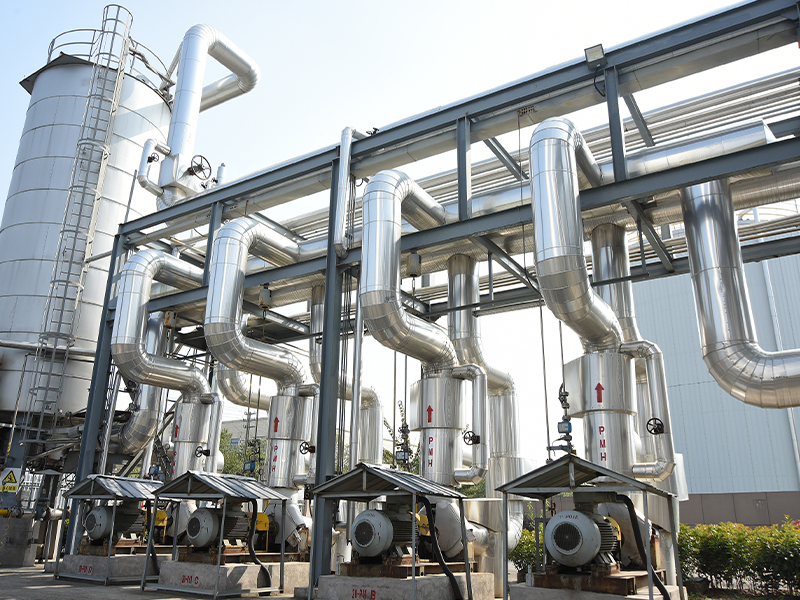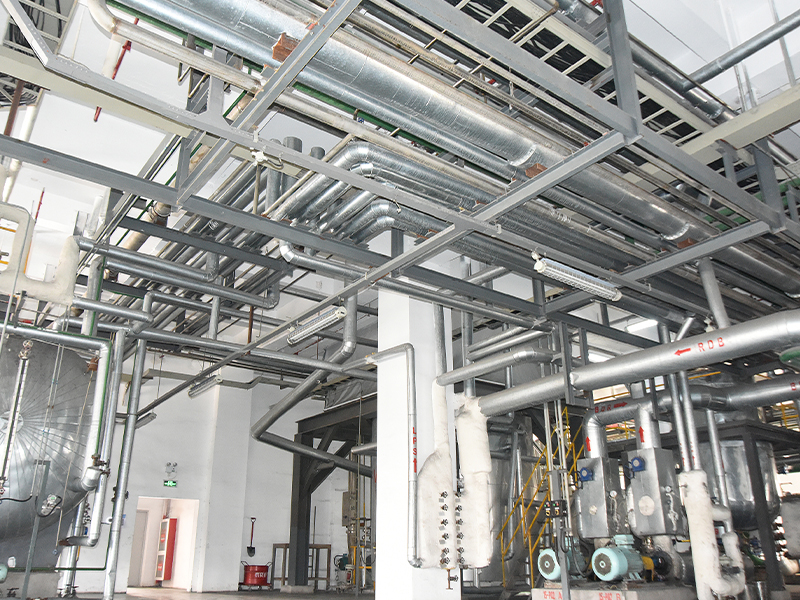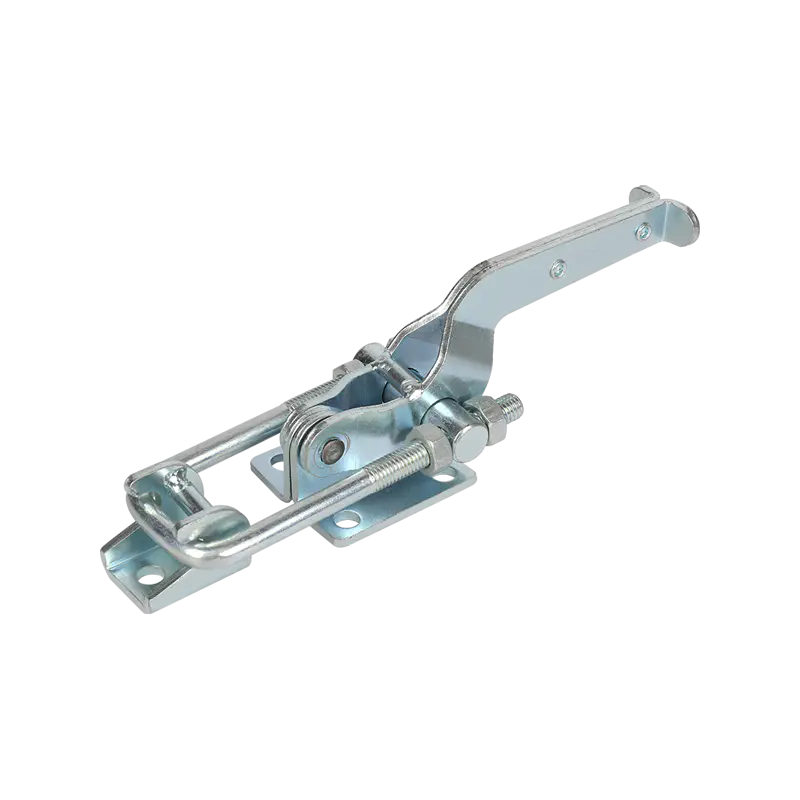1. Material composition: A variety of steels give diverse performances
The main material of Steel J-Shaped Hook Latch Action Toggle Clamp is steel. Different types of steel are suitable for different application scenarios due to their different performance.
(I) Galvanized steel: Considering both cost and basic protection
Galvanized steel is formed by hot-dip galvanizing or electroplating on the surface of steel to form a zinc layer. Zinc has an active chemical property and can quickly form a dense zinc oxide film in the air. This film is like a solid barrier, isolating oxygen, moisture and corrosive media from contact with the steel matrix, and effectively improving the corrosion resistance of the clamp. In ordinary industrial environments, such as the fixing of equipment shells in general factories and the connection of simple steel frame structures, galvanized steel clamps can work stably and resist daily environmental erosion, and the cost is relatively low and cost-effective.
(II) Nickel-plated steel: Both beautiful and performance
Nickel-plated steel is a nickel layer plated on the surface of steel. Nickel not only has good corrosion resistance, but also gives the clip a bright and beautiful metallic texture. The nickel-plated layer has high hardness and excellent wear resistance, which can reduce the damage caused by friction and collision during use. In situations where both appearance and performance are required, such as the connection of precision parts inside high-end instruments and equipment, and the fixing of delicate housings of electronic equipment, nickel-plated steel clips can not only ensure a stable connection, but also improve the overall grade of the product, meeting the user's dual needs for quality and beauty.
(III) AISI 304 stainless steel: A strong man for extreme environments
AISI 304 stainless steel is a common austenitic stainless steel, with chromium and nickel as the main alloying elements. Chromium makes the surface of stainless steel form a stable and strong chromium oxide passivation film, which has self-repairing ability. Even if the surface is damaged, it can be quickly regenerated in an aerobic environment, greatly enhancing the corrosion resistance of the material. The addition of nickel improves the toughness and machinability of stainless steel, making it adaptable to complex manufacturing processes. In fields such as chemical equipment, food processing equipment, and marine engineering, which require extremely high corrosion resistance, ordinary steel is susceptible to corrosion and failure, while 304 stainless steel clips can work stably for a long time with their excellent performance, ensuring the safe operation of equipment and extending the service life of equipment.
II. Manufacturing process: multiple processes to create high-quality products
The production of steel J-type hook-shaped latch-type hinged clamps requires multiple key links, and each process has an important impact on the final performance and quality of the product.
(I) Forging process: Laying the foundation for component strength
Key components such as the body, latch frame, and clamping rod of the clamp are often manufactured using forging technology. During forging, the forging machine applies pressure to the metal billet to cause it to undergo plastic deformation. In this process, the internal structure of the metal changes, the grains are refined and distributed more evenly, and the strength and toughness of the material are significantly improved. By precisely controlling parameters such as forging temperature, pressure, and deformation, parts with complex shapes and high dimensional accuracy can be manufactured to meet the design requirements of the clamp. For example, the J-hook part of the clip needs to have a specific shape and sufficient strength to achieve the hooking and locking functions. The forging process can accurately shape its appearance and give it the required strength to ensure stability and reliability during use.
(II) Machining process: improving dimensional accuracy and surface quality
The forged parts need to be machined for further optimization. Turning can process the outer circle, inner hole and end face of the part, and obtain high-precision dimensions and smooth surfaces by accurately controlling the tool movement trajectory and cutting parameters. Milling is used to process various planes, grooves, steps and complex contours to create specific structures and connection parts for each part of the clip. Drilling is a common method for making mounting holes, pin holes, etc. to ensure that the clip fits accurately with other parts. The grinding process is used to further improve the surface finish and dimensional accuracy of the parts, eliminate minor defects and errors in the processing process, make the surface quality of the clip meet the design standards, and ensure that the hinged parts are flexible and stable, and open and close smoothly.
(III) Surface treatment process: enhancing performance and extending life
Surface treatment is crucial to improving the performance and service life of the clip. In addition to galvanizing and nickel plating, blackening treatment is also a common process. Blackening treatment generates a black oxide film on the surface of steel through chemical reaction. This film not only improves corrosion resistance, but also has a certain lubricating effect, reducing the friction resistance when the clamp moves, making the operation smoother. For the moving parts of the clamp, such as bearing bolts, pins, etc., grease lubrication treatment is carried out to reduce the friction coefficient, reduce wear, and extend the service life of the parts. During the surface treatment process, the processing temperature, time, solution concentration and other parameters are strictly controlled to ensure that the processing quality and effect are uniform and consistent, and meet the performance requirements under different use environments.
III. Application field: widely used in multiple industry scenarios
With its unique structure and reliable performance, the steel J-type hook-shaped latch-type articulated clamp is widely used in many fields.
(I) Industrial equipment manufacturing: ensuring equipment assembly and operation
In industrial equipment manufacturing, this clamp is often used for equipment assembly and fixation. When connecting the shell of large mechanical equipment, this clamp can quickly connect the parts and provide sufficient clamping force to ensure that the shell will not loosen when the equipment is running, even if it is subjected to external forces such as vibration and impact. For equipment hatches and covers that need to be frequently opened for maintenance and repair, the hinged and latched design of the clip makes operation easy and improves equipment maintenance efficiency. In automated production line equipment, the clip can fix and position parts to ensure the accuracy and stability of the production process and ensure product quality.
(II) Transportation tools: ensuring safety and convenience
In the manufacturing and maintenance of transportation tools such as automobiles, trains, and ships, clips play an important role. When manufacturing automobiles, they can be used to connect and fix the engine hood and trunk lid to ensure that the lid will not be accidentally opened during driving, and it is convenient for users to open it. On trains and ships, they are used to fix equipment hatches, storage box doors and detachable structural components. During transportation, even in complex road conditions or severe sea conditions, the components can be ensured to be safe and stable. If the ship is shaken by the impact of waves while sailing, the clip can tightly lock the hatch to prevent seawater from entering and ensure the safety of the ship.
(III) Warehousing and logistics equipment: assisting in the storage and transportation of goods
In warehousing and logistics equipment, shelves, cargo boxes, etc. often use this type of clip. When the shelves are assembled, the clips connect the beams and columns to enhance the structural stability of the shelves and ensure that the shelves will not deform or collapse when storing goods. For foldable or detachable cargo boxes, the clips make it easy to open and close and fix the cargo boxes, which is convenient for loading and unloading. During logistics transportation, the clips can fix the goods to prevent the goods from shifting and falling due to vehicle bumps, ensuring that the goods are safely delivered to the destination.
(IV) Outdoor facilities and temporary structures of buildings: Adapting to special environmental needs
Clamps are widely used in outdoor facilities such as street light pole maintenance doors, outdoor distribution box door fixation, and temporary structure connections for construction, such as scaffolding component connections and construction guardrail fixation. The outdoor environment is complex and changeable. With corrosion-resistant steel and high-quality surface treatment technology, the clips can withstand the test of natural factors such as wind, sun, rain, snow and frost, and work stably for a long time. At the construction site, its convenient installation and disassembly characteristics can improve construction efficiency and meet the requirements for structural connections at different construction stages.
IV. Advantages: Core competitiveness with excellent performance
The steel J-hook latch-type hinged clamp has many significant advantages, making it stand out in the field of connection and fixation.
(I) High clamping force and stability: ensuring safe operation of the system
The unique design of the clamp enables it to provide strong clamping force. In the locked state, the J-hook and the latch work closely together to firmly clamp the connected object and ensure the stability of the connection part. When subjected to large external forces, such as equipment vibration and transportation vehicle bumps, it can still maintain a firm clamping and is not easy to loosen and fall off, providing reliable guarantee for the safe operation of the entire system. Compared with other connection clamps, it has obvious stability advantages under high load and dynamic load environments, and can meet application scenarios with extremely high requirements for connection reliability.
(II) Easy operation and fast installation and disassembly: improving work efficiency
The hinged design of the clamp makes it extremely easy to operate. When installing, align the opening of the clamp with the connection part, and by simply rotating or pressing, the J-hook can enter the locking position to complete the connection; when disassembling, the corresponding unlocking operation can be quickly removed. This convenience has significant advantages in frequent equipment maintenance, component replacement or structural adjustment work, which can greatly improve work efficiency and reduce downtime. For example, in daily maintenance of industrial equipment, maintenance personnel can quickly open the equipment casing for inspection and quickly restore equipment operation.
(III) Good corrosion resistance and durability: reduce use cost
Thanks to materials and surface treatment processes such as galvanized steel, nickel-plated steel and stainless steel, the clamp has excellent corrosion resistance. Under harsh conditions such as humid industrial environments, acid and alkali corrosion chemical sites, and high-salinity marine environments, it can still maintain stable performance and structural integrity. At the same time, high-quality steel and excellent manufacturing technology give the clamp high strength and wear resistance. It is not easy to deform and wear due to frequent use, and has a long service life, which reduces the cost of use.
(IV) Strong adaptability and good versatility: meet diverse needs
The clamp design can adapt to objects of different shapes and sizes to be connected, and can meet various connection needs by adjusting the model specifications. Whether it is connecting thin metal sheets or thick structural components, there are suitable clamps to choose from. It is widely used in many industries and fields. Its standardized design and manufacturing make it highly versatile in the market, easy for users to purchase, and can be used interchangeably in different equipment and structures, thus improving resource utilization efficiency.
Industry News
Home / News / Industry News / What kind of material technology, application scenarios and advantages does Steel J-Shaped Hook Latch Action Toggle Clamp have?
Industry News
Jun 26, 2025 POST BY ADMIN
What kind of material technology, application scenarios and advantages does Steel J-Shaped Hook Latch Action Toggle Clamp have?
Message Feedback
News & EVENT
Product Categories
Recent Posts
If You Are Interested
In Our Products,
Please Consult Us
In Our Products,
Please Consult Us
Copyright © 2023 Shanghai Bingshuo Hardware & Machinery Co., Ltd. All Rights Reserved.
OEM/ODM Industrial Stainless Steel Hardware Latch Toggle Clamp Suppliers
Privacy
 English
English Español
Español русский
русский




